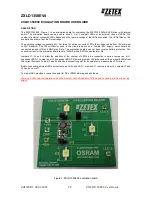
80
http://www.tyan.com
embedded on the motherboard, to be used as just an I/O controller or to be the
I/O component of a hardware RAID subsystem. The RAIDIOS circuit allows an
I/O Processor (either embedded on the motherboard or on an add-in card) to
configure the I/O controller and service the I/O controller’s interrupts. The I/O
controller and the I/O Processor together are two of the primary components of
a hardware RAID subsystem.
RAM (Random Access Memory):
technically refers to a type of memory where
any byte can be accessed without touching the adjacent data, is often used to
refer to the system’s main memory. This memory is available to any program
running on the computer.
ROM (Read-Only Memory):
a storage chip which contains the BIOS; the basic
instructions required to boot the computer and start up the operating system.
SATA (Serial ATA):
is an evolutionary replacement for the Parallel ATA
physical storage interface. Serial ATA is a drop-in solution in that it is
compatible with today’s software and operating systems. It will provide for
systems which are easier to design, with cables that are simpler to route and
install, smaller cable connectors, and lower voltage requirements.
SDRAM (Synchronous Dynamic RAM):
called as such because it can keep
two sets of memory addresses open simultaneously. By transferring data
alternately from one set of addresses and then the other, SDRAM cuts down on
the delays associated with non-synchronous RAM, which must close one
address bank before opening the next.
Serial port:
called as such because it transmits the eight bits of a byte of data
along one wire, and receives data on another single wire (that is, the data is
transmitted in serial form, one bit after another).
SCSI Interrupt Steering Logic (SISL):
Architecture that allows a RAID
controller, such as AcceleRAID 150, 200 or 250, to implement RAID on a
system board-embedded SCSI bus or a set of SCSI busses. SISL: SCSI
Interrupt Steering Logic ( LSI ) (only on LSI SCSI boards)
SIMM (Single In-line Memory Module):
formally the most common form of
RAM for motherboards. They must be installed in pairs, and do not have the
carrying capacity or the speed of DIMM modules.
Sleep/Suspend mode:
in this mode, all devices except the CPU shut down.
SRAM (Static RAM):
unlike DRAM, this type of RAM does not need to be
refreshed in order to prevent data loss. Thus, it is faster and more expensive.
SSI (Server System Infrastructure):
an industry initiative intended to provide
ready-to-use design specifications for common server hardware elements
Summary of Contents for S5162
Page 9: ...2 2 Block Diagram Tomcat i7230W S5162 9 http www tyan com ...
Page 12: ...JP43 JP30 JP25 JP24 JP16 12 http www tyan com ...
Page 16: ...JP40 JP14 JP42 JP41 16 http www tyan com ...
Page 32: ...32 http www tyan com NOTE ...
Page 55: ...3 3 4 Hardware Monitor 55 http www tyan com ...
Page 56: ...3 3 4 1 Voltage Monitoring 56 http www tyan com ...
Page 70: ...70 http www tyan com NOTE ...




































